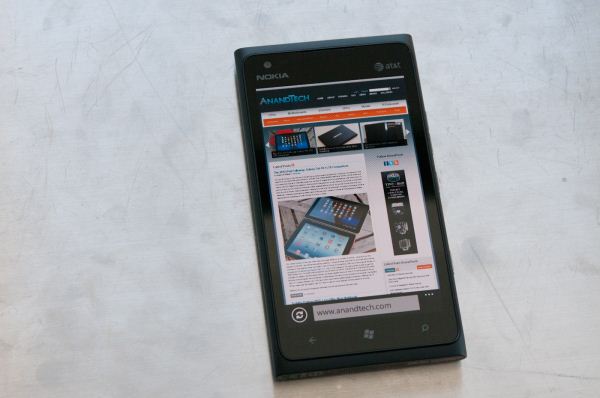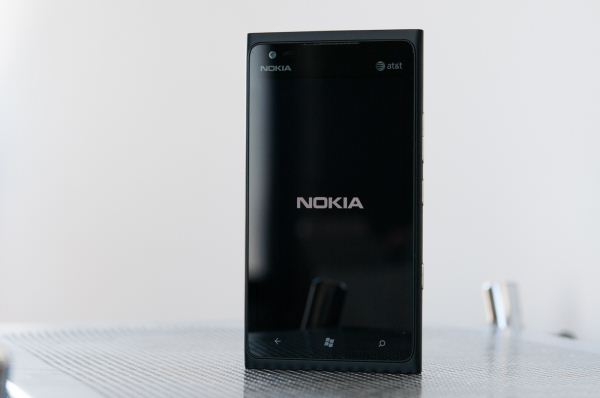Nokia Lumia 900 Review - Windows Phone with LTE
by Brian Klug on April 3, 2012 9:00 PM ESTSumming up the Lumia 900 as a device is pretty easy, it's superficially a beefed up, larger Lumia 800. Spelled out explicitly, the changes are a larger 4.3" SAMOLED+ display with a full RGB stripe, a front facing 720p camera, and LTE connectivity for AT&T. When it launches later in Europe, instead of LTE, the Lumia 900 will bring DC-HSPA+ and all around improved cellular connectivity courtesy MDM9200. The Lumia 900 is thinner, but obviously larger in x and y to accommodate the larger display, but in the hand and pocket the difference isn't all that huge. The end result is a device I can find only positive things to talk about with, and it's the Lumia that finally rounds out Nokia's complete entrant Windows Phone lineup.
For the first time in a while, I'm genuinely excited by a new Windows Phone. With the Lumia 900, it seems as though some of Nokia's rhetoric about being the first OEM to put its best hardware and design forward with the platform is starting to ring true. Similar to our take on the first members of the Lumia family, the 900 is easily the best Windows Phone on the market today.
The $99 launch price is absolutely crazy and very welcome for a flagship phone, particularly one with such high build quality and camera standards. Not only does this obviate other Windows Phones, but it increases competitive pressure on Apple as well as Android smartphone providers. I don't know that there's still a lot of iPhone/Windows Phone cross shopping, but a trend towards even cheaper on-contract prices for high-end smartphones is absolutely welcome.
What we really need to see from Nokia is faster hardware and more power efficient LTE, both of these things are technically possible today (28nm LTE basebands are still not quite available in volume yet) however it's up to Microsoft to actually enforce the platform change. It's amazing what Nokia has been able to do hardware-wise with only a year in the Microsoft camp, particularly when you remember that most smartphone development cycles are in the 12 - 24 month range. While the Lumia 900 is a great Windows Phone today, what will really be interesting is what Nokia will be able to pull off with a full design cycle under its belt.
The Lumia 900 launch in the US is, like I stated before, obviously a big deal for Nokia, and putting its best devices on the table with the 900 makes sense, even if the initial Lumia 710 introduction was something of a puzzling first step. While it's a big deal for Nokia to be launching a flagship phone in the US once more, it really isn't as much of a make or break thing for the Windows Phone 7 platform in general, and that brings me to my next point.
Ultimately the Lumia 900 doesn't really change the balance of power in the smartphone OS competition as it stands right now. Although the version number has advanced on the Lumia 900 (because of changes that needed to accommodate LTE), it's really the same Windows Phone 7.5 Mango we've seen and talked about before. If you're looking for a make or break launch that might upset the balance, wait for the Apollo update.
As it enables dual-core SoCs, the Apollo update leads to our continued plea to Microsoft: please throw better hardware at the Windows Phone platform. No company ever won by being the slowest. Windows Phone may be an extremely efficient platform (it is), but there are only good things to come from combining software efficiency with bleeding edge hardware. Microsoft has learned tremendously from Apple in this regard, but in order for Windows Phone to be more than a third runner up it needs to push the envelope just as much as Apple has been. Microsoft will eventually adopt Krait, and 28nm LTE is equally inevitable, but it would just be nice to see those things sooner rather than later on Windows Phone. At some point for a platform to be a winner, it must actually be industry leading. I suspect all of this will come as a part of Microsoft's Windows 8 strategy. Waiting is never easy.












128 Comments
View All Comments
lunarx3dfx - Wednesday, April 4, 2012 - link
I agree with edd. I recently bought a focus flash after using a Nexus S for almost a year, and even with ics the Nexus wasn't anywhere near as smooth as WP7 is. Sure, gpu acceleration helped, but there are other underlying problems in Android.That being said however, I will probably be getting the HTC ONE X or the US GSM Galaxy Nexus (if it ever launches) because the one area WP really lacks is in providing features for power users. It is a beautiful os, and as a whole I really enjoy it, but I miss being able to customize everything like I could on android.
papatom - Wednesday, April 4, 2012 - link
Besides there is a lot more that the underlying OS has to offer.Let's see how WP subjective performance changes (tanks?) when Microsoft adds all those features.
They will bring the platform in-line feature wise, won't they?
Another thing, as pointed by Exodite, is that the first crop of WP phones - at least reference ones - comes from Nokia, and is polished to the point OS permits.
sprockkets - Wednesday, April 4, 2012 - link
I'm at 1.2ghz and 768 memory with only around 400 available for me to use! Sure it's dual core, but again, the GPU does its job now.Here, read this from an actual developer of Android.
https://plus.google.com/105051985738280261832/post...
mutatio - Wednesday, April 4, 2012 - link
Careful, Vision, that comes awful close to complimenting Apple's approach since day one of the iPhone. ;-)Exodite - Wednesday, April 4, 2012 - link
Ah yes, the wonders of anecdotal evidence and conjecture.Incidentially I have an Android phone based on very similar hardware, an 1GHz Qualcomm S2 SoC, 512MB memory and a FWVGA display.
And it runs absolutely beautifully.
It's the SE arc though, kinda funny how the old guard in phones still seem to come up with some of the best solutions.
designerfx - Friday, April 6, 2012 - link
wow, really?do you understand the point of quad core? it's not performance, it's more power savings.
WP is not more efficient than anyone - if you think it is the OS, you don't understand that probably 99% of the performance (positive or negative) is based on the chips in the phone and that's it.
crispbp04 - Tuesday, April 10, 2012 - link
You are clueless so please don't speak on subjects you have no idea about. Do you even know what a scheduling is? Maybe when you get an education some day after you graduate high school you'll understand how an operating system works.http://en.wikipedia.org/wiki/Scheduling_(computing...
Saying performance is all hardware is like saying strengh is everything. try holding a 25lb weight 2 feet from you with your arms extended, then hold the same weight to your chest. What is easier?
eddman - Tuesday, April 3, 2012 - link
Why talk time and 3G web browsing battery times are so low, compared to phones with a similar display and a similar or smaller battery?Is this one of the pitfalls of using a dedicated baseband chip?
Brian Klug - Wednesday, April 4, 2012 - link
Basically that, and again that we're talking about (at least for the cellular page loading tests) the same display being the majority of power draw.The tethering results being so close surprised me, and I'm going to re-run the HSPA+ result just to see what was up there. Again very limited time on this review actually.
-Brian
Lonegunman2012 - Wednesday, April 4, 2012 - link
Just a quick question: What is your rush to get the review out? I look to this site for thoroughly written reviews. It's disappointing that so much was left out. I would be happy to wait longer for a review to come out if it was complete.